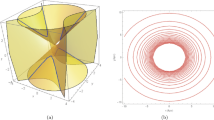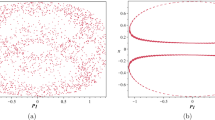Abstract
We study the families of simple periodic orbits in a three-dimensional system that represents the inner parts of a perturbed triaxial galaxy. The perturbations depend on two control parameters. We find the regions where each family is stable, simply unstable, doubly unstable, or complex unstable. the stable and simply unstable families produce other families by bifurcation. Several families reach a maximum (or minimum) perturbation and then are continued by other families. The bifurcations are direct or inverse. The transition from one type of bifurcation to the other is theoretically explained. Another important phenomenon is the splitting of one family into two, or the joining of two families into one. We do not have any complex instability in the limiting cases of two-dimensional motions (when one control parameter is zero).
The two main families of periodic orbits are in most cases stable when the energy is smaller than the escape energy. Most high energy orbits are unstable. However, we found stable orbits even for energies about four times larger than the escape energy.
Similar content being viewed by others
References
Broucke, R.: 1969,Am. Inst. Aeronaut. Astronaut. J. 7 1003.
Contopoulos, G.: 1965,Astron. J. 70, 526.
Contopoulos, G.: 1970,Astron. J. 75, 196.
Contopoulos, G.: 1981,Celest. Mech. 24, 355.
Contopoulos, G.: 1983a,Lett. Nuovo. Cimento 38, 257.
Contopoulos, G.: 1983b,Physica 8D, 142.
Contopoulos, G.: 1984,Physica 11D, 179.
Contopoulos, G., Magnenat, P., and Martinet, L.: 1982,Physica 6D, 126.
Hadjidemetriou, J. D.: 1975,Celest. Mech. 12, 255.
Hénon, M.: 1965,Ann. Astrophys. 28, 992.
Krein, M. G.: 1950,Dokl. Akad. Nauk USSR 73, 445.
Magnenat, P.: 1982a,Astron. Astrophys. 108, 89.
Magnenat, P.: 1982b,Celest. Mech. 28, 319.
Martinet, L., and Magnenat, P.: 1981,Astron. Astrophys. 96, 68.
Moser, J. K.: 1958,Commun. Pure Appl. Math. 11, 81.
Schwarzschild, M.: 1979,Astrophys. J. 232, 236.
Author information
Authors and Affiliations
Rights and permissions
About this article
Cite this article
Contopoulos, G., Magnenat, P. Simple three-dimensional periodic orbits in a galactic-type potential. Celestial Mechanics 37, 387–414 (1985). https://doi.org/10.1007/BF01261627
Received:
Accepted:
Issue Date:
DOI: https://doi.org/10.1007/BF01261627




